
Concept explainers
(a)
Interpretation: The Haworth projection for
Concept introduction: The structural representation of sugar molecule in cyclic form is known as Haworth projection. Sugar molecule that has six-membered-ring is known as pyranose and sugar molecule that has five-membered-ring is called furanose.
Answer to Problem 28.45P
The Haworth projection for
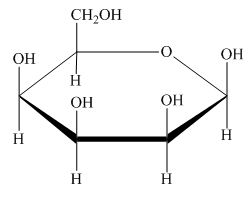
Explanation of Solution
The structure of D-talose is,
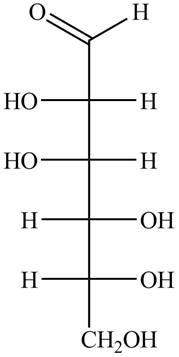
Figure 1
The steps for the conversion of Fischer projection of D-talose into Haworth projection is as follow:
Step-1 Talopyranose ring is formed by the attack of
Step 2 The Haworth projection of D-talopyranose,
Step 3 In the beta-form, the substituents
Step-4 The substituents which are present on the right side in the Fischer projection are drawn on the below the ring in the Haworth projection. Similarly, the substituents which are present on the left side in the Fischer projection are drawn on the above the ring in the Haworth projection.
The conversion of D-talose into

Figure 2
The Haworth projection for
(b)
Interpretation: The Haworth projection for
Concept introduction: The structural representation of sugar molecule in cyclic form is known as Haworth projection. Sugar molecule that has six-membered-ring is known as pyranose and sugar molecule that has five-membered-ring is called furanose.
Answer to Problem 28.45P
The Haworth projection for
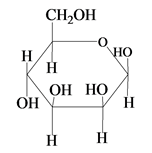
Explanation of Solution
The structure of D-mannose is,

Figure 3
The steps for the conversion of Fischer projection of D-mannose into Haworth projection is as follow:
Step-1 Mannosepyranose ring is formed by the attack of
Step 2 The Haworth projection of D-mannosepyranose,
Step 3 In the beta-form, the substituents
Step-4 The substituents which are present on the right side in the Fischer projection are drawn on the below the ring in the Haworth projection. Similarly, the substituents which are present on the left side in the Fischer projection are drawn on the above the ring in the Haworth projection.
The conversion of D-mannose into D-mannosepyranose is shown below.
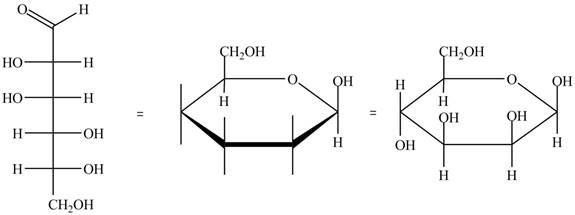
Figure 4
The Haworth projection for
(c)
Interpretation: The Haworth projection for
Concept introduction: The structural representation of sugar molecule in cyclic form is known as Haworth projection. Sugar molecule that has six-membered-ring is known as pyranose and sugar molecule that has five-membered-ring is called furanose.
Answer to Problem 28.45P
The Haworth projection for
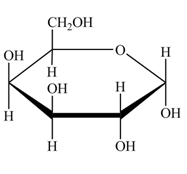
Explanation of Solution
The structure of D-galactose is,
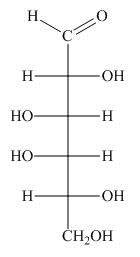
Figure 5
The steps for the conversion of Fischer projection of D-galactose into Haworth projection is as follow:
Step-1 Galactopyranose ring is formed by the attack of
Step 2 The Haworth projection of D-galactopyranose,
Step 3 In the alpha-form, the substituents
Step-4 The substituents which are present on the right side in the Fischer projection are drawn on the below the ring in the Haworth projection. Similarly, the substituents which are present on the left side in the Fischer projection are drawn on the above the ring in the Haworth projection.
The conversion of D-galactose into D-galactopyranose is shown below.
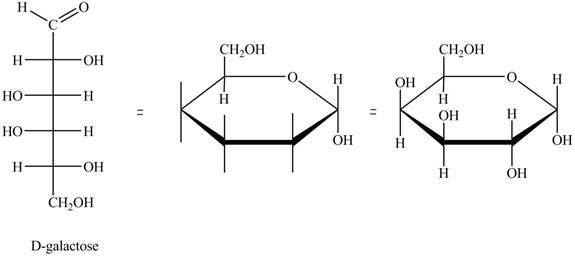
Figure 6
The Haworth projection for
(d)
Interpretation: The Haworth projection for
Concept introduction: The structural representation of sugar molecule in cyclic form is known as Haworth projection. Sugar molecule that has six-membered-ring is known as pyranose and sugar molecule that has five-membered-ring is called furanose.
Answer to Problem 28.45P
The Haworth projection for
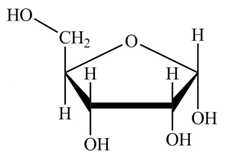
Explanation of Solution
The structure of D-ribose is,

Figure 7
The steps for the conversion of Fischer projection of D-ribose into Haworth projection is as follow:
Step-1 Ribofuranose ring is formed by the attack of
Step 2 The Haworth projection of D-ribofuranose,
Step 3 In the alpha-form, the substituents
Step-4 The substituents which are present on the right side in the Fischer projection are drawn on the below the ring in the Haworth projection. Similarly, the substituents which are present on the left side in the Fischer projection are drawn on the above the ring in the Haworth projection.
The conversion of D-ribose into D-ribofuranose is shown below.
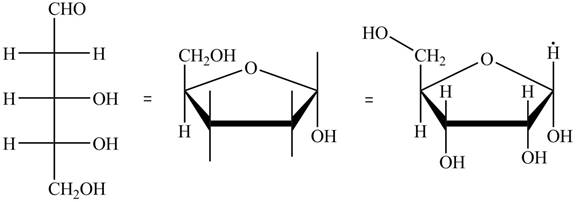
Figure 8
The Haworth projection for
(e)
Interpretation: The Haworth projection for
Concept introduction: The structural representation of sugar molecule in cyclic form is known as Haworth projection. Sugar molecule that has six-membered-ring is known as pyranose and sugar molecule that has five-membered-ring is called furanose.
Answer to Problem 28.45P
The Haworth projection for

Explanation of Solution
The structure of D-tagatose is,
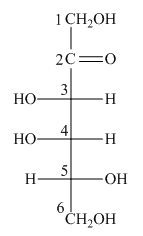
Figure 9
The steps for the conversion of Fischer projection of D-tagatose into Haworth projection is as follow:
Step-1 Tagatofuranose ring is formed by the attack of
Step 2 The Haworth projection of D-tagatofuranose,
Step 3 In the alpha-form, the substituents
Step-4 The substituents which are present on the right side in the Fischer projection are drawn on the below the ring in the Haworth projection. Similarly, the substituents which are present on the left side in the Fischer projection are drawn on the above the ring in the Haworth projection.
The conversion of D-tagatose into D-tagatofuranose is shown below.
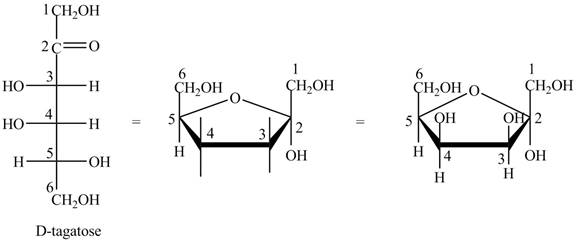
Figure 10
The Haworth projection for
Want to see more full solutions like this?
Chapter 28 Solutions
Organic Chemistry-Package(Custom)
- DATA: Standard Concentration (caffeine) mg/L Absorbance Reading 10 0.322 20 0.697 40 1.535 60 2.520 80 3.100arrow_forwardIn what position will p-Toluidine be nitrated and what will the compound be called.arrow_forwardIn what position will 4-methylbenzonitrile be nitrated and what will the compound be called.arrow_forward
- In what position will benzenesulfonic acid be nitrated?arrow_forwardIf compound A reacts with an excess of methyl iodide and then heated with aqueous Ag₂O, indicate only the major products obtained. Draw their formulas. A Harrow_forwardExplanation Check 1:01AM Done 110 Functional Groups Identifying and drawing hemiacetals and acetals In the drawing area below, create a hemiacetal with 1 ethoxy group, 1 propoxy group, and a total of 9 carbon atoms. Click and drag to start drawing a structure. ✓ $ 2025 McGraw Hill LLC. All Rights Reserved. Terms of Use Sarrow_forward
- Write the systematic name of each organic molecule: CI structure CI CI Explanation CI ठ CI Check B ☐ 188 F1 80 name F2 F3 F4 F5 F6 60 F7 2arrow_forwardWrite the systematic name of each organic molecule: structure i HO OH Explanation Check name ☐ ☐arrow_forwardX 5 Check the box under each molecule that has a total of five ẞ hydrogens. If none of the molecules fit this description, check the box underneath the table. CI Br Br Br 0 None of these molecules have a total of five ẞ hydrogens. Explanation Check esc F1 F2 tab caps lock fn Q @2 A W # 3 OH O OH HO © 2025 McGraw Hill LLC. All Rights Reserved. Terms of Use | Privacy Center | Accessibility IK F7 F7 F8 TA F9 F10 & 6 28 * ( > 7 8 9 0 80 F3 O F4 KKO F5 F6 S 64 $ D % 25 R T Y U பட F G H O J K L Z X C V B N M H control option command P H F11 F12 + || { [ command optionarrow_forward
- An open vessel containing water stands in a laboratory measuring 5.0 m x 5.0 m x 3.0 m at 25 °C ; the vapor pressure (vp) of water at this temperature is 3.2 kPa. When the system has come to equilibrium, what mass of water will be found in the air if there is no ventilation? Repeat the calculation for open vessels containing benzene (vp = 13.1 kPa) and mercury (vp = 0.23 Pa)arrow_forwardEvery chemist knows to ‘add acid to water with constant stirring’ when diluting a concentrated acid in order to keep the solution from spewing boiling acid all over the place. Explain how this one fact is enough to prove that strong acids and water do not form ideal solutions.arrow_forwardThe predominant components of our atmosphere are N₂, O₂, and Ar in the following mole fractions: χN2 = 0.780, χO2 = 0.21, χAr = 0.01. Assuming that these molecules act as ideal gases, calculate ΔGmix, ΔSmix, and ΔHmix when the total pressure is 1 bar and the temperature is 300 K.arrow_forward
 Introduction to General, Organic and BiochemistryChemistryISBN:9781285869759Author:Frederick A. Bettelheim, William H. Brown, Mary K. Campbell, Shawn O. Farrell, Omar TorresPublisher:Cengage Learning
Introduction to General, Organic and BiochemistryChemistryISBN:9781285869759Author:Frederick A. Bettelheim, William H. Brown, Mary K. Campbell, Shawn O. Farrell, Omar TorresPublisher:Cengage Learning General, Organic, and Biological ChemistryChemistryISBN:9781285853918Author:H. Stephen StokerPublisher:Cengage Learning
General, Organic, and Biological ChemistryChemistryISBN:9781285853918Author:H. Stephen StokerPublisher:Cengage Learning Organic And Biological ChemistryChemistryISBN:9781305081079Author:STOKER, H. Stephen (howard Stephen)Publisher:Cengage Learning,
Organic And Biological ChemistryChemistryISBN:9781305081079Author:STOKER, H. Stephen (howard Stephen)Publisher:Cengage Learning,


